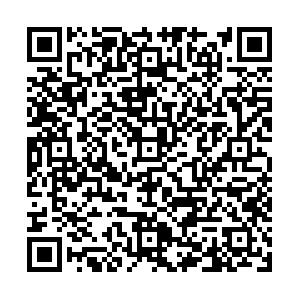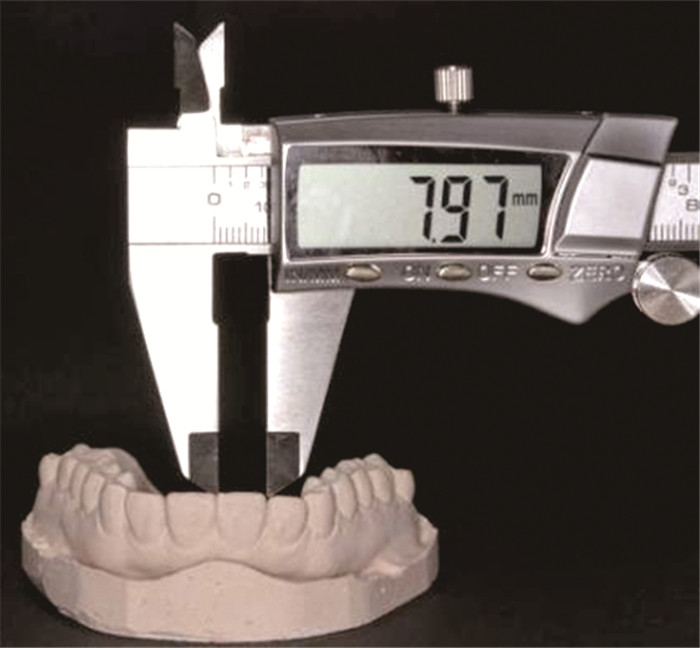Reliability evaluation of manual and digital measurements for orthodontic models under different crowding degrees
-
摘要:
目的 评估不同拥挤程度下牙颌模型数字化测量的可靠性、准确性,以明确数字化模型测量在口腔正畸临床工作中的应用前景。 方法 选取2020年9月—2021年9月在蚌埠医学院第一附属医院口腔正畸科就诊患者30副正畸石膏记存模型,并扫描石膏模型获得30副数字化模型。依据拥挤度的大小划分为轻度(拥挤度≤4 mm)、中度(4 mm < 拥挤度≤8 mm)和重度拥挤组(拥挤度>8 mm),每组各10副模型。石膏模型用游标卡尺测量相关参数,数字化模型用相应软件测量,比较2种测量方法在测量相关参数时所得结果之间存在的差异。 结果 轻度拥挤组中,7个测量值之间的差异有统计学意义(P < 0.05): 14、36、44、46牙位的牙冠宽度、上颌牙弓前段长度、下颌牙弓后段长度、腭穹高度;中度拥挤组中,9个测量值之间的差异有统计学意义(P < 0.05): 16、26、36、45、46牙位的牙冠宽度、上颌牙弓前段长度、下颌牙弓中段长度、覆合、测量时间;重度拥挤组中,10个测量值之间的差异有统计学意义(P < 0.05): 15、13、12、11、23、43牙位的牙冠宽度、上颌牙弓后段宽度、下颌牙弓中段长度、覆合、测量时间,但以上结果所存在的差异均 < 1 mm。 结论 牙列的拥挤程度虽对数字化模型的测量结果具有一定的影响,但并不影响临床正畸方案制定,数字化模型测量可替代传统的手工测量方法在临床上应用。 Abstract:Objective To evaluate the reliability and accuracy of digital measurement of dental model under different levels of crowding, so as to clarify the application prospect of digital model measurement in orthodontic clinical work. Methods A total of 30 sets of orthodontic plaster were selected as storage models in the Department of Orthodontics of the First Affiliated Hospital of Bengbu Medical College from September 2020 to September 2021, and 30 digital models were obtained by scanning the gypsum model. According to the crowding degree, they were divided into mild group (crowding degree ≤4 mm), moderate group (4 mm < crowding degree≤8 mm) and severe crowding group (crowding degree >8 mm), with 10 models in each group. The gypsum model was measured with vernier caliper, and the digital model was measured with corresponding software. The difference between the results of the two measurement methods when measuring relevant parameters was compared. Results In the mild crowding group, the difference between the 7 measurement values was statistically significant (P < 0.05): crown width, maxillary anterior arch length, mandibular posterior arch length, and palatal dome height at 14, 36, 44, and 46 positions. In the moderately crowded group, the difference between nine measurements was statistically significant (P < 0.05): Crown width, anterior length of maxillary arch, middle length of mandibular arch, overlaying, and measurement time at 16, 26, 36, 45, 46 positions. In the severe crowding group, the difference between the 10 measurements was statistically significant (P < 0.05): 15, 13, 12, 11, 23, 43 tooth position crown width, maxillary posterior arch width, mandibular arch middle length, overlying, measurement time. However, the difference between the above results was less than 1 mm. Conclusion Although the degree of dentition crowding has a certain influence on the measurement results of the digital model, it does not affect the development of clinical orthodontic plan. The digital model measurement can replace the traditional manual measurement method in clinical application. -
Key words:
- Digital model /
- Model measurement /
- Reliability /
- Repetitive
-
表 1 不同拥挤组2种测量方式测量牙冠宽度的差值(x±s, mm)
Table 1. Difference in crown width measured by the two measurement methods in different crowding groups(x±s, mm)
组别 例数 17 16 15 14 13 12 11 21 轻度拥挤组 10 0.08±0.58 -0.04±0.09 -0.17±0.27 -0.31±0.40a 0.07±0.36 0.06±0.34 0.06±0.24 0.03±0.19 中度拥挤组 10 0.08±0.50 -0.31±0.29a 0.06±0.36 -0.16±0.46 0.12±0.18 0.06±0.28 0.00±0.27 -0.00±0.27 重度拥挤组 10 0.09±0.52 -0.12±0.26 -0.25±0.31a 0.08±0.42 0.30±0.19a 0.16±0.21a 0.11±0.14a 0.08±0.26 组别 例数 22 23 24 25 26 27 37 36 轻度拥挤组 10 -0.09±0.38 -0.21±0.30 -0.23±0.44 -0.09±0.34 -0.09±0.14 0.08±0.47 0.08±0.48 -0.28±0.22a 中度拥挤组 10 -0.01±0.34 -0.07±0.22 0.01±0.40 0.09±0.49 -0.21±0.28a -0.17±0.41 -0.01±0.27 -0.29±0.38a 重度拥挤组 10 0.11±0.36 0.24±0.19a 0.14±0.55 0.12±0.35 0.03±0.42 0.08±0.21 -0.03±0.26 -0.25±0.43 组别 例数 35 34 33 32 31 41 42 43 轻度拥挤组 10 -0.15±0.33 -0.00±0.20 -0.01±0.22 -0.01±0.31 0.04±0.18 0.12±0.20 0.10±0.16 0.10±0.19 中度拥挤组 10 -0.12±0.40 -0.09±0.37 0.08±1.89 0.29±0.25 0.11±0.17 0.01±0.49 0.07±0.25 0.10±0.19 重度拥挤组 10 -0.16±0.31 -0.14±0.23 0.04±0.24 0.21±0.25 0.13±0.27 0.06±0.30 0.09±0.34 0.14±0.15a 组别 例数 44 45 46 47 上牙弓
应有长度下牙弓
应有长度上牙弓
现有长度下牙弓
现有长度轻度拥挤组 10 0.32±0.31a -0.13±0.20 -0.23±0.19a -0.06±0.51 -0.92±1.45 0.40±1.22 -0.60±1.09 -0.21±1.63 中度拥挤组 10 -0.07±0.53 -0.24±0.33a -0.36±0.30a -0.07±0.45 0.08±1.69 0.30±1.71 -0.37±1.59 0.22±1.96 重度拥挤组 10 0.04±0.23 -0.18±0.49 -0.01±0.49 0.06±0.59 0.05±0.44a 0.22±1.32 0.60±1.51 0.18±1.38 注:2种测量方式所得结果比较,aP < 0.05。 表 2 不同拥挤组2种测量方式测量牙弓宽度、牙弓长度和腭穹高度的差值(x±s, mm)
Table 2. Differences in arch width, arch length, and palatal vault height measured by the two measurement methods in different crowding groups(x±s, mm)
组别 例数 上牙弓前
段宽度中段宽度 后段宽度 下牙弓前
段宽度中段宽度 后段宽度 轻度拥挤组 10 -0.02±0.45 -0.09±0.28 0.02±0.72 -0.38±0.45 -0.23±0.77 -0.64±0.39 中度拥挤组 10 -0.21±0.38 0.15±0.38 0.21±0.72 -0.39±0.33 -0.05±0.62 -0.40±0.55 重度拥挤组 10 1.32±5.37 0.22±0.19 1.00±0.43 -0.09±0.23 -0.09±0.70 -0.23±0.64 组别 例数 上牙弓前
段长度中段长度 后段长度 下牙弓前
段长度中段长度 后段长度 腭穹高度 轻度拥挤组 10 0.81±0.66a 0.02±0.52 -0.00±0.62 0.18±0.25 -0.06±0.09 0.57±0.47a -0.73±0.69a 中度拥挤组 10 0.81±0.53a -0.15±0.41 -0.41±0.96 0.24±0.36 -0.82±0.52a 0.08±0.70 -0.37±0.86 重度拥挤组 10 0.23±0.71 0.42±1.04 0.12±0.42 0.37±0.82 -0.85±0.90a 0.45±0.78 0.84±2.96 注:2种测量方式所得结果比较,aP < 0.05。 表 3 不同拥挤组2种测量方式测量拥挤度的差值(x±s, mm)
Table 3. Difference in crowding measured by the two measurement methods in different crowding groups(x±s, mm)
组别 例数 上颌 下颌 轻度拥挤组 10 -0.28±1.19 0.62±1.85 中度拥挤组 10 0.45±1.00 0.04±1.56 重度拥挤组 10 0.44±1.69 0.03±1.77 表 4 不同拥挤组2种测量方式测量覆合、覆盖的差值(x±s,mm)
Table 4. Difference values of overbite and overbite measured by two measurement methods in different crowding groups(x±s, mm)
组别 例数 覆合 覆盖 轻度拥挤组 10 0.11±0.59 0.13±0.63 中度拥挤组 10 0.80±0.53a 0.08±0.78 重度拥挤组 10 0.47±0.62a -0.04±1.15 注:2种测量方式所得结果比较,aP < 0.05。 表 5 不同拥挤组2种测量方式所需时间及其差值(x±s, min)
Table 5. Time required by the two measurement methods and their differences in different crowding groups(x±s, min)
组别 例数 手工测量
时间数字化测量
时间差值 t值 P值 轻度拥挤组 10 16.46±1.13 16.56±1.31 -0.10±1.57 0.200 0.846 中度拥挤组 10 15.16±0.91 17.26±0.81 -2.10±1.23a 5.360 < 0.001 重度拥挤组 10 15.09±0.64 16.53±0.91 -1.43±1.16a 3.894 0.004 注:2种测量方式所得结果比较,aP < 0.05。 -
[1] LIANG Y M, RUTCHAKITPRAKARN L, KUANG S H, et al. Comparing the reliability and accuracy of clinical measurements using plaster model and the digital model system based on crowding severity[J]. J Chin Med Assoc, 2018, 81(9): 842-847. doi: 10.1016/j.jcma.2017.11.011 [2] 郑小婉, 刘金平, 黄晓峰. 轻重度拥挤正畸模型. 手工测量和数字化测量的可靠性评价研究[J]. 临床口腔医学杂志, 2021, 37(7): 395-399. doi: 10.3969/j.issn.1003-1634.2021.07.004ZHENG X W, LIU J P, HUANG X F. Reliability evaluation of manual and digital measurement of mild and severe crowding orthodontic model[J]. Journal of Clinical Stomatology, 2021, 37(7): 395-399. doi: 10.3969/j.issn.1003-1634.2021.07.004 [3] 杜丽娟, 田梦婷, 张嘉宇, 等. 三维数字化模型测量牙齿和牙弓的精确性研究[J]. 口腔材料器械杂志, 2018, 27(4): 200-204. https://www.cnki.com.cn/Article/CJFDTOTAL-KCCL201804005.htmDU L J, TIAN M T, ZHANG J Y, et al. Study on the accuracy of measurement of dental arches by three-dimensional digital model[J]. Chinese Journal of Dental Materials and Devices, 2018, 27(4): 200-204. https://www.cnki.com.cn/Article/CJFDTOTAL-KCCL201804005.htm [4] 杨雷宁, 韩晓鹏, 张萌萌, 等. 牙颌数字化模型与石膏模型在线距和角度测量方面的准确性研究[J]. 口腔医学研究, 2019, 35(8): 802-805. https://www.cnki.com.cn/Article/CJFDTOTAL-KQYZ201908030.htmYANG L N, HAN X P, ZHANG M M, et al. Veracity of digital models and stone cast by studying distance and angle[J]. Journal of Oral Science Research, 2019, 35(8): 802-805. https://www.cnki.com.cn/Article/CJFDTOTAL-KQYZ201908030.htm [5] 李彬, 段沛沛, 白丁. 数字化技术在口腔正畸诊疗中的应用[J]. 口腔医学, 2021, 41(1): 71-75. https://www.cnki.com.cn/Article/CJFDTOTAL-KQYX202101019.htmLI B, DUAN P P, BAI D. Application of digital technology in diagnosis and treatment of orthodontics[J]. Stomatology, 2021, 41(1): 71-75. https://www.cnki.com.cn/Article/CJFDTOTAL-KQYX202101019.htm [6] ANH J W, PARK J M, CHUN Y S, et al. A comparison of the precision of three-dimensional images acquired by 2 digital intraoral scanners: effects of tooth irregularity and scanning direction[J]. Korean J Orthod, 2016, 46(1): 3-12. doi: 10.4041/kjod.2016.46.1.3 [7] 张晖榕, 尹乐锋, 刘艳丽, 等. 基于锥形术CT数字化建模的3D打印牙颌模型制作及精确度研究[J]. 华西口腔医学杂志, 2018, 36(2): 156-161. https://www.cnki.com.cn/Article/CJFDTOTAL-HXKQ201802012.htmZHANG H R, YIN L F, LIU Y L, et al. Fabrication and accuracy research on 3D printing dental model based on cone beam computed tomography digital modeling[J]. West China Journal of Stomatology, 2018, 36(2): 156-161. https://www.cnki.com.cn/Article/CJFDTOTAL-HXKQ201802012.htm [8] REUSCHL R P, HEUER W, STIESCH M, et al. Reliability and validity of measurements on digital study models and plaster models[J]. Eur J Orthod, 2016, 38(1): 22-26. doi: 10.1093/ejo/cjv001 [9] 赵志河. 口腔正畸学[M]. 7版. 北京: 人民卫生出版社, 2020: 51-59.ZHAO Z H. Chinese Journal of Orthodontics[M]. 7th Ed. Beijing: People's Medical Publishing House, 2020: 51-59. [10] 惠宇, 吴亮颖, 张卫平, 等. 数字化口内扫描印模技术的发展和应用研究[J]. 现代医药卫生, 2019, 35(19): 2993-2996. doi: 10.3969/j.issn.1009-5519.2019.19.017HUI Y, WU L Y, ZHANG W P, et al. Development and application of digital in-mouth scanning impression technology[J]. Journal of Modern Medicine & Health, 2019, 35(19): 2993-2996. doi: 10.3969/j.issn.1009-5519.2019.19.017 [11] YUKI T, JUN U, MASAHIRO K, et al. Accuracy of digital models gener-ated by conventional impression /plaster-model methods and intraoral scanning[J]. Dent Mater J, 2018, 37(4): 628-633. doi: 10.4012/dmj.2017-208 [12] VERMA R K, SINGH S P, VERMA S, et al. Comparison of reliability, validity, and accuracy of linear measurements made on pre- and posttreatment digital study models with conventional plaster study models[J]. J Orthod Sci, 2019, 8: 18. DOI: 10.4103/jos.JOS_14_19. [13] ROSSI D S, ROMANO M, SWEED A H, et al. Use of CAD-CAM technology to improve orthognathic surgery outcomes in patients with severe obstructive sleep apnoea syndrome[J]. J Craniomaxillofac Surg, 2019, 47(9): 1331-1337. doi: 10.1016/j.jcms.2019.06.010 [14] 胡红艳, 罗武香, 张丽丽. 三维数字化牙颌模型在口腔正畸学中的应用[J]. 全科口腔医学电子杂志, 2019, 6(30): 20-21. https://www.cnki.com.cn/Article/CJFDTOTAL-QKKQ201930015.htmHU H Y, LUO W X, ZHANG L L. Application of three-dimensional digital dental model in orthodontics[J]. Electronic Journal of General Stomatology, 2019, 6(30): 20-21. https://www.cnki.com.cn/Article/CJFDTOTAL-QKKQ201930015.htm [15] 刘金平, 郑小婉, 黄晓峰. 数字化正畸模型测量的可靠性研究[J]. 医学研究杂志, 2021, 50(2): 90-93. https://www.cnki.com.cn/Article/CJFDTOTAL-YXYZ202102022.htmLIU J P, ZHENG X W, HUANG X F. Reliability evaluation of digital orthodontic model measurement[J]. Journal of Medical Research, 2021, 50(2): 90-93. https://www.cnki.com.cn/Article/CJFDTOTAL-YXYZ202102022.htm [16] 王记位, 贾筱诗, 张斌, 等. 数字化记存模型在口腔正畸实验教学中的应用[J]. 广州医科大学学报, 2020, 48(4): 63-64. https://www.cnki.com.cn/Article/CJFDTOTAL-GZXI202004015.htmWANG J W, JIA X S, ZHANG B, et al. Application of digital memory model in orthodontic experimental teaching[J]. Academic Journal of Guangzhou Medical University, 2020, 48(4): 63-64. https://www.cnki.com.cn/Article/CJFDTOTAL-GZXI202004015.htm [17] GÜL AMUK N, KARSLI E, KURT G. Comparison of dental measurements between conventional plaster models, digital models obtained by impression scanning and plaster model scanning[J]. Int Orthod, 2019, 17(1): 151-158. [18] LICZMANSKI K, STAMM T, SAUERLAND C, et al. Accuracy of intraoral scans in the mixed dentition: a prospective non-randomized comparative clinical trial[J]. Head Face Med, 2020, 16(1): 11. DOI: 10.1186/s13005-020-00222-6. [19] YOON J H, YU H S, CHOI Y, et al. Model analysis of digital models in moderate to severe crowding: in vivo validation and clinical application[J]. Biomed Res Int, 2018, 2018: 8414605. DOI: 10.1155/2018/8414605. [20] 陈幸, 刘奇, 陈锋, 等. 全科口腔医学的现状和发展[J]. 中华全科医学, 2022, 20(5): 721-724. doi: 10.16766/j.cnki.issn.1674-4152.002439CHEN X, LIU Q, CHEN F, et al. Current situation and future development of general stomatology[J]. Chinese Journal of General Practice, 2022, 20(5): 721-724. doi: 10.16766/j.cnki.issn.1674-4152.002439 -





 下载:
下载:




